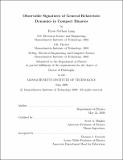Observable signatures of general relativistic dynamics in compact binaries
Author(s)
Lang, Ryan N. (Ryan Nathan)
DownloadFull printable version (2.327Mb)
Other Contributors
Massachusetts Institute of Technology. Dept. of Physics.
Advisor
Scott A. Hughes.
Terms of use
Metadata
Show full item recordAbstract
The effects of general relativity (GR) in astrophysical systems are often difficult to calculate, but they can have important consequences for observables. This thesis considers the impact of previously-ignored GR effects in two different types of compact binary systems. The first is the coalescence of massive black holes in high-redshift galaxies. The gravitational waves (GWs) from these systems can be detected by the proposed low-frequency gravitational wave detector LISA and used to determine the various parameters which characterize the binary. Most studies of LISA's parameter estimation capability have ignored a significant piece of physics: the relativistic precession of the binary's angular momentum vectors. In the first two-thirds of this thesis, we show how including precession effects in the waveform model helps to break various degeneracies and improve the expected parameter errors. We give special attention to the localization parameters, sky position and distance. When distance is converted to an approximate redshift, these parameters define a "pixel" on the sky in which astronomers can search for an electromagnetic counterpart to the GW event. The final third of this thesis focuses on stellar -mass compact binaries in which at least one member is a neutron star. The measurement of tidal effects in these systems may shed some light on the poorly understood high-density equation of state. We first calculate the point at which a neutron star tidally disrupts in the field of a black hole. Previous calculations of this effect have used Newtonian self-gravity, which is inappropriate for a neutron star; we correct this by using relativistic perturbation theory. (cont.) We then turn to small tidal distortions of neutron stars, which can be characterized by a quantity known as the Love number. We calculate relativistic Love numbers for a wide variety of equations of state and investigate their impact on the GWs from neutron star-neutron star binaries.
Description
Thesis (Ph. D.)--Massachusetts Institute of Technology, Dept. of Physics, 2009. This electronic version was submitted by the student author. The certified thesis is available in the Institute Archives and Special Collections. Cataloged from student submitted PDF version of thesis. Includes bibliographical references (p. 217-237).
Date issued
2009Department
Massachusetts Institute of Technology. Department of PhysicsPublisher
Massachusetts Institute of Technology
Keywords
Physics.